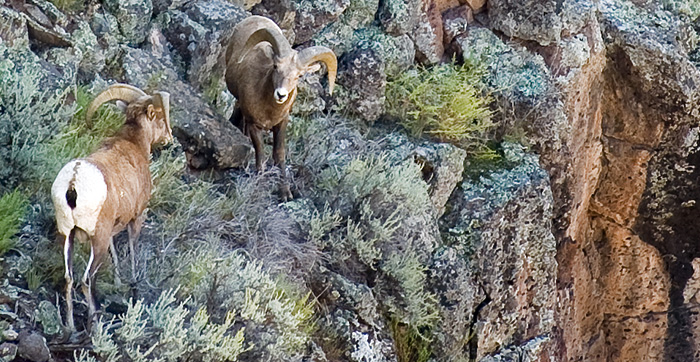
Rocky Mountain Bighorn Sheep
Rocky Mountain bighorn sheep are an important species of wildlife for New Mexico both as a big game trophy and as watchable wildlife. A group of rams grazing high in an alpine meadow is a stunning sight that exemplifies the meaning of wilderness. Through active management and conservation measures, wildlife biologists have successfully brought back this sensitive species so that is no longer endangered.
Overview

Rocky Mountain bighorn sheep in cliffside habitat exemplify the New Mexico wilderness.
Grade level: Grades 6-8 and Grades 9-12
Content Areas: Science, Math, English/Language Arts
Objectives: Students will–
- read informational text and learn about the natural history of the Rocky Mountain bighorn sheep.
- learn new vocabulary.
- correlate data from a chart to a line graph.
- make inferences based on text and chart data.
- create line graph using chart data on Rocky Mountain bighorn sheep populations.
- practice questioning and making statements using Bounce Card technique.
Method: Students read informational text: a Wildlife Note on Rocky Mountain bighorn sheep. Students learn vocabulary (see end of lesson) by creating illustrated and written definitions while participating in group discussion that is seminar style seating where teacher leads and facilitates. Students use information from the Department’s web site including the Rocky Mountain Bighorn Sheep Wildlife Note, and Rocky Mountain Bighorn Population Trends – line graph of Rocky Mountain bighorn sheep population from 2003-2014 and a chart showing the population numbers for individual bighorn sheep herds in various regions of the state. Students use a Bounce Card that guides them in group discussions. Students produce Quick Writes (see Resources on the Extension tab) in their science notebooks.
Materials:
- Department information including Wildlife Note, line graph and population chart of Rocky Mountain bighorn sheep in New Mexico from 2003-2013
- Bounce Card, duplicated in lesson from ASCD Education Update, Volume 55: Number 12, December 2013. Original source from Total Participation Techniques: Making Every Student an Active Learner, by P. Himmele & W. Himmele, 2011, Alexandria, VA.
- School materials such as graph paper, laptops and/or tablets, pencils, rulers
- Student science notebooks
- Teacher may use a projector to open the Department web pages for whole class to view.
- Optional: Rocky Mountain Critter Box that is available for check-out from the Department.
Lesson and Activity Time: About 2 to 3 class sessions—Time needed for new skills related to Common Core State Standards and reading informational text. Grades 6-8 may need additional time.
Location: Classroom or large conference room for initial seminar discussion
Academic Standards: [wpfilebase tag=file id=2384 tpl=filebrowser /]
Vocabulary
Adversely, browse, carrying capacity, cud, dominance, ecology, encroachment, extirpated, forage, gestation, herbivore, limiting factors, mortality, muzzle, persistence/persisting populations, pneumonia, population poaching, population, predation, Quick Writes, regurgitate, remnant population
Background
- This activity is based on data collected from 2003 to 2012 for the Rocky Mountain bighorn sheep population in the Pecos Wilderness, New Mexico. All references in this lesson to bighorn sheep are the Rocky Mountain bighorn sheep (Ovis canadensis canadensis). See resource web site for information on all North American sheep. Click here to see map of NM and Rocky Mountain bighorn sheep habitat locations.
- The Pecos Wilderness consists of 17,422 acres of bighorn habitat. It currently supports an increasing bighorn sheep population, after a multiple-year population decline due to population expanding beyond what habitat could support. Populations in decline occur when the carrying capacity of the habitat cannot support the number of animals grazing. Mountain lion predation can negatively affect bighorn sheep populations. In areas where too many sheep are killed by mountain lions (cougars), hunts are increased.
- The herd is protected by very limited hunts. Detailed information can be found in the New Mexico Hunting Rules and Information booklet, available on Department web site, www.wildlife.state.nm.us
- Both aerial and ground surveys are conducted by wildlife biologists.
- Surveys help wildlife managers determine the number of animals in herds and the number of animals that can be hunted and harvested from an area.
- Ground surveys are done by hiking above timberline in the alpine zone. Biologists are out for 3-4 days with as many as 5 people at a time. Department biologists have decades of experience and know where the herds are and how to spot them. The biologists have masters and doctorate degrees and have published research papers on bighorn sheep. They are also experienced at trapping and relocating individual bighorn to different locations. The Department has periodic “trapping events” where large teams of people are involved in airlifting and trucking animals to new locations. The surveys help determine if and when this is necessary to keep the populations healthy and at or under the habitat’s carrying capacity. The carrying capacity refers to the number of animals the habitat can hold over the long-term without damaging habitat quality.
Procedure
1. Engage students by using the bighorn sheep critter box that can be checked out by contacting the Information and Education Division at NM Department of Game and Fish, 505-476-8095. This box has a ram skull with curled horns.
The difference between antlers and horns: Antlers, on members of the deer family, are grown as an extension of the animal’s skull. They are true bone and are a single structure found only on males. Antlers are shed and regrown each year. Horns, found on pronghorn, bison and bighorn sheep are two-part structures. An interior of bone (an extension of the skull) is covered by an exterior sheath grown by specialized hair follicles. Human fingernails and the exterior of horns are made of a similar material, known as keratin. With the exception of pronghorn, horns are never shed and they continue to grow throughout an animal’s life. Pronghorn shed and regrow horn sheaths each year. Rams can be aged by counting the rings on their horns. The first ring forms at age 1 ½ years.
2. Engage further by going to the NM Department of Game and Fish web site. Click on the Conservation tab at the top of the opening page. Open page for Bighorn Sheep Management (Conservation -> New Mexico Wildlife Species -> Mammals -> Bighorn sheep). This page has a color photo of large rams above treeline. Click the following PDF’s for identification and photo gallery (Bighorn – Ewes – Rams Identification Guide and Bighorn – Ewes – Rams Photo Gallery) . Either print this page for students or have students open on their devices. The photos have captions explaining how to identify ewes (females) from rams (males). These are all young animals. Note small horns compared to opening page image of large adults with curled horns.
3. Ask students to do a Quick Writes (see Extension tab) on everything they know about Rocky Mountain bighorn sheep and/or any words that come to mind after exploring the critter box and after looking at photos from step 2.
4. Create a KWL list using student information from step 2. Save list and create another at end of lesson to assess how much students learned.
5. Students read Wildlife Note: Rocky Mountain Bighorn Sheep (This Wildlife Note is located under Education -> Conservation Education -> Educational Materials. Any advanced vocabulary definitions can be found in the Curriculum’s Glossary).
6. Arrange desks in large circle, seminar style for group discussion. Seminar style is large circle with everyone facing the group. Teacher sits within circle and can move at random, as needed for management purposes and to teach this style of group discussion.
- Read Wildlife Note out loud (teacher decides how much one person reads) and go around circle reading and charting new vocabulary words in science notebooks. Teacher may want to list on white board or project list from a laptop.
- As a whole class, discuss natural history of Rocky Mountain bighorn sheep, using categories on Wildlife Note-range, habitat, description, behavior, diet, reproduction and conservation. Click here to see photos from a bighorn sheep trap and transplant operation.
- Allow class time for defining new words. Many words are used in sophisticated ways that may be unfamiliar to students. Teacher will need to facilitate vocabulary discussion and understanding for each section of Wildlife Note. Students may want to try making picture grams as definitions. For example, the word extirpated in the first paragraph could be drawn as a plant being dug up by its roots. One definition for extirpated is “rooted out.” The Rocky Mountain bighorn sheep did not become extinct, but their populations were reduced dramatically by the Westward expansion of the U.S. in the 1800’s and early 1900’s.
- Ask students to do a Quick Write after reading each section and after discussing vocabulary. Students may also create graphic organizer to write reflections and understanding thus far.
- To facilitate discussions and to assist students in learning how to talk, listen and ask questions, use the Bounce Card that is referred to in materials and is reproduced here with this lesson.
- Teacher periodically checks that Quick Writes have been completed throughout the activity.
- Questions to check for understanding, based on Wildlife Note:
• What were three causes for the decrease in Rocky Mountain bighorn sheep?
• After several failed attempts at reintroducing these bighorn sheep, what prohibition allowed the Rocky Mountain bighorn sheep to successfully establish in the Pecos Wilderness, wheeler Peak Wilderness and Latir Peak Wilderness?
• Describe the physical characteristics that are different between the rams and the ewes.
7. Using the Rocky Mountain Bighorn Population Trends, find the population counts from 2003 to 2013 in table and graph formats. Print and make copies for students. Students should be able to explain the simple line graph for total population numbers from the chart. Click here to see map of NM and Rocky Mountain bighorn sheep habitat locations.
8. Look at numbers for the Pecos Wilderness herd on the chart. Students should notice how the population for the Pecos declines starting around 2007 and it drops dramatically by 2010; and then the population numbers increase from 2011 to 2014. Students can make inferences about why the population declined. See first paragraph under the heading Conservation on the Rocky Mountain Bighorn Sheep Wildlife Note. Students may infer:
- Some animals got sick or starved.
- Not enough predators in the high mountains, so the population got too large and as a consequence the high altitude habitat did not have enough food for all of the herd.
- The primary predator of Rocky Mountain bighorn sheep is the mountain lion, also called a cougar. In the past, wolves would have preyed on bighorn sheep as well. The wolf is now extirpated from most of New Mexico. The exception is the USFWS reintroduction program for the Mexican wolf. This effort is centered in the southwest part of the state in the Gila Wilderness and locations in neighboring Arizona.
Information from Department biologists: Several years of heavy snows and hard winters caused animals to starve. As the habitat recovered, the population rebounded and began to grow again. This is an important concept known as carrying capacity .
9. Students draw a line graph similar to the example on the handout, for another region’s bighorn sheep population from 2003-2014.
- Note areas where there were no sheep for some years, Dry Cimarron and Rio Grande Gorge. The chart shows a small population for each area (2006, 2007) that is due to those animals being moved there from elsewhere by the Department. Periodically there are “sheep traps” where sheep are trapped in an over populated region and moved to new regions in the state.
- Using chart showing transplant history going back to 1940. Note on chart the release site column and the years that the bighorn sheep were introduced starting the populations for Dry Cimarron and for the Rio Grande Gorge. Both of these sites had a zero population prior to this trapping and relocating event. This information corresponds to the numbers on the chart that students are using for population trends.
Extension Wrap-up and Assessment
Students
- Students create individual Quick Writes to summarize what they have learned about Rocky Mountain bighorn sheep.
- Students work in small groups to create a Quick Write, with each student offering one sentence in a round-robin fashion.
Teacher
- Assesses participation during seminar-style discussions, along with use of the Bounce Card technique.
- Checks Quick Writes that have been done before, during and after the activity; and checks other diagrams, and vocabulary definitions in student notebooks.
Resources
Web site from Wyoming on North American Wild Sheep, National Bighorn Sheep Center:
http://www.bighorn.org/biology.html
Quick Writes: A versatile strategy used to develop writing fluency, to build the habit of reflection into learning experiences and to informally assess student thinking. Students write for 2 – 10 minutes, responding to a question, or prompt related to the text. This is done without organizing it too much or worrying about grammar. See additional information in the Appendices. (Reproduction allowed for educational use. Teachers may want to reproduce, laminate and cut into smaller size).

